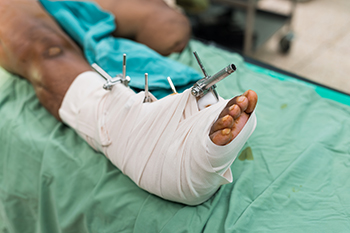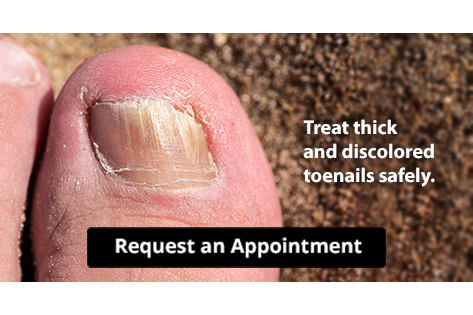
External fixation of an ankle fracture is a surgical treatment that uses a frame outside the leg connected to pins or wires that are placed into the bone. This method stabilizes the fracture and allows proper healing, especially when swelling or severe trauma prevents immediate internal fixation. Ankle fractures can result from falls, sports injuries, or accidents, leading to pain, swelling, and instability. During surgery, the podiatric surgeon places pins into the bone above and below the fracture, attaching them to an external frame to keep the bones aligned. A podiatrist helps guide recovery, monitor healing, and manage long-term function. If you have sustained an ankle injury, it is suggested that you contact a podiatrist who can provide you with effective treatment solutions, which may include this type of surgery.
Foot surgery is sometimes necessary to treat a foot ailment. To learn more, contact one of our doctors of Hamilton Foot and Ankle Associates. Our doctors will assist you with all of your foot and ankle needs.
When Is Surgery Necessary?
Foot and ankle surgery is generally reserved for cases in which less invasive, conservative procedures have failed to alleviate the problem. Some of the cases in which surgery may be necessary include:
- Removing foot deformities like bunions and bone spurs
- Severe arthritis that has caused bone issues
- Cosmetic reconstruction
What Types of Surgery Are There?
The type of surgery you receive will depend on the nature of the problem you have. Some of the possible surgeries include:
- Bunionectomy for painful bunions
- Surgical fusion for realignment of bones
- Neuropathy decompression surgery to treat nerve damage
Benefits of Surgery
Although surgery is usually a last resort, it can provide more complete pain relief compared to non-surgical methods and may allow you to finally resume full activity.
Surgical techniques have also become increasingly sophisticated. Techniques like endoscopic surgery allow for smaller incisions and faster recovery times.
If you have any questions, please feel free to contact our offices located in Brooklyn, New York, NY . We offer the newest diagnostic and treatment technologies for all your foot care needs.
 Patients who have bunions may notice their daily activities can be interrupted as a result of the pain and discomfort they may cause. It appears as a bony protrusion on the side of the big toe, and it may make it difficult to wear shoes. A bunion can gradually form from genetic factors, or from wearing shoes that do not fit correctly. Patients have found mild relief when a protective pad is worn on top of the bunion, in addition to soaking the affected foot in warm water. If the bunion is prominent, surgery may be an option which is referred to as a bunionectomy. There are toe exercises that can be performed which can be helpful in strengthening the overall foot. If you notice the beginning signs of a bunion, it is suggested that you speak with a podiatrist who can guide you toward the correct treatment technique.
Patients who have bunions may notice their daily activities can be interrupted as a result of the pain and discomfort they may cause. It appears as a bony protrusion on the side of the big toe, and it may make it difficult to wear shoes. A bunion can gradually form from genetic factors, or from wearing shoes that do not fit correctly. Patients have found mild relief when a protective pad is worn on top of the bunion, in addition to soaking the affected foot in warm water. If the bunion is prominent, surgery may be an option which is referred to as a bunionectomy. There are toe exercises that can be performed which can be helpful in strengthening the overall foot. If you notice the beginning signs of a bunion, it is suggested that you speak with a podiatrist who can guide you toward the correct treatment technique.
If you are suffering from bunion pain, contact one of our doctors of Hamilton Foot and Ankle Associates. Our doctors can provide the care you need to keep you pain-free and on your feet.
What Is a Bunion?
Bunions are painful bony bumps that usually develop on the inside of the foot at the joint of the big toe. As the deformity increases over time, it may become painful to walk and wear shoes. Women are more likely to exacerbate existing bunions since they often wear tight, narrow shoes that shift their toes together. Bunion pain can be relieved by wearing wider shoes with enough room for the toes.
Causes
- Genetics – some people inherit feet that are more prone to bunion development
- Inflammatory Conditions - rheumatoid arthritis and polio may cause bunion development
Symptoms
- Redness and inflammation
- Pain and tenderness
- Callus or corns on the bump
- Restricted motion in the big toe
In order to diagnose your bunion, your podiatrist may ask about your medical history, symptoms, and general health. Your doctor might also order an x-ray to take a closer look at your feet. Nonsurgical treatment options include orthotics, padding, icing, changes in footwear, and medication. If nonsurgical treatments don’t alleviate your bunion pain, surgery may be necessary.
If you have any questions, please feel free to contact our offices located in Brooklyn, New York, NY . We offer the newest diagnostic and treatment technologies for all your foot care needs.
 Circulation describes the movement of blood throughout the body. Having good circulation in your legs and feet is essential for good health, but sometimes our circulation can deteriorate as we age or can become worse due to certain medical conditions. Fortunately, there are things that you can do to improve circulation throughout your body. Doing light exercises, such as walking and stretching, increases blood flow throughout the body and can lower your blood pressure. Sitting in a position that does not cut off circulation to your legs is also very important. Try sitting in a chair with your legs spaced slightly apart and your feet on the floor rather than sitting cross legged. If you are a smoker, quitting can improve both your overall health and your circulation. If you have poor circulation in your lower limbs, it is recommended that you consult a podiatrist for treatment.
Circulation describes the movement of blood throughout the body. Having good circulation in your legs and feet is essential for good health, but sometimes our circulation can deteriorate as we age or can become worse due to certain medical conditions. Fortunately, there are things that you can do to improve circulation throughout your body. Doing light exercises, such as walking and stretching, increases blood flow throughout the body and can lower your blood pressure. Sitting in a position that does not cut off circulation to your legs is also very important. Try sitting in a chair with your legs spaced slightly apart and your feet on the floor rather than sitting cross legged. If you are a smoker, quitting can improve both your overall health and your circulation. If you have poor circulation in your lower limbs, it is recommended that you consult a podiatrist for treatment.
Poor circulation is a serious condition and needs immediate medical attention. If you have any concerns with poor circulation in your feet contact one of our doctors of Hamilton Foot and Ankle Associates. Our doctors will treat your foot and ankle needs.
Poor Circulation in the Feet
Poor blood circulation in the feet and legs is can be caused by peripheral artery disease (PAD), which is the result of a buildup of plaque in the arteries.
Plaque buildup or atherosclerosis results from excess calcium and cholesterol in the bloodstream. This can restrict the amount of blood which can flow through the arteries. Poor blood circulation in the feet and legs are sometimes caused by inflammation in the blood vessels, known as vasculitis.
Causes
Lack of oxygen and oxygen from poor blood circulation restricts muscle growth and development. It can also cause:
- Muscle pain, stiffness, or weakness
- Numbness or cramping in the legs
- Skin discoloration
- Slower nail & hair growth
- Erectile dysfunction
Those who have diabetes or smoke are at greatest risk for poor circulation, as are those who are over 50. If you have poor circulation in the feet and legs it may be caused by PAD and is important to make changes to your lifestyle in order to reduce risk of getting a heart attack or stroke. Exercise and maintaining a healthy lifestyle will dramatically improve conditions.
As always, see a podiatrist as he or she will assist in finding a regimen that suits you. A podiatrist can also prescribe you any needed medication.
If you have any questions, please feel free to contact our offices located in Brooklyn, New York, NY . We offer the newest diagnostic and treatment technologies for all your foot care needs.

